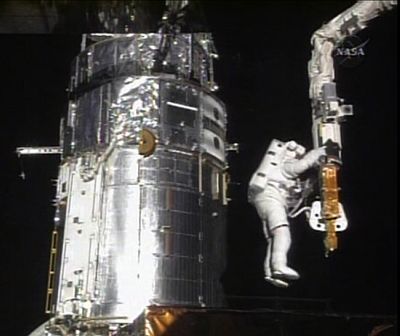Astronauts wrap up Hubble renovation
Telescope repairs, upgrades should last up to 10 years

CAPE CANAVERAL, Fla. – Spacewalking astronauts completed repairs to the Hubble Space Telescope on Monday, leaving it more powerful than ever and able to peer even deeper into the cosmos – almost to the brink of creation.
The last humans to lay hands on Hubble outfitted the observatory with another set of fresh batteries, a new sensor for precise pointing and protective covers. That equipment, along with other improvements made over the last five days, should allow the telescope to provide dazzling views of the universe for another five to 10 years.
“This is a very important moment in human history,” Hubble senior project scientist David Leckrone said in Houston. “We will rewrite the textbooks at least one more time.”
It was the fifth and final spacewalk for the shuttle Atlantis crew, and the final visit by astronauts ever to Hubble.
The astronauts planned to set Hubble free from the shuttle’s cargo bay today.
During this emotional last house call, astronauts gave Hubble two state-of-the-art science instruments and fixed two others.
The $220 million worth of new instruments should allow the telescope to gaze farther back into time – within 500 million or 600 million years of the first moments of the universe.
Prior to the repairs, Hubble was able to look back to within 800 million years.
Hubble program manager Preston Burch acknowledged that the telescope still has some original parts, but noted “in many ways it is a brand-new observatory and far, far more capable than the Hubble of 1990.”
Mission Control congratulated the astronauts for successfully completing “electronic brain surgery” Monday during a spacewalk that lasted more than seven hours.
In addition to the batteries and the sensor, Hubble’s chief mechanic, John Grunsfeld, and Andrew Feustel installed steel foil sheets to protect against radiation and the extreme temperature changes of space.
It was messy work. Pieces of the old insulation broke off and floated harmlessly away.
“I was hoping to retrieve those for memories,” said Grunsfeld, an astrophysicist who has spent more time working on the orbiting Hubble than anyone. He’s visited Hubble twice before, and plans to use the telescope once he’s back on Earth to study the moon.
During the mission, the four spacewalkers, two per team, managed to fix two science instruments that had broken down years ago and were never meant to be tinkered with in orbit.
They also replaced a faltering science data-handling device and installed a docking ring so a robotic craft can latch on and steer the telescope into the Pacific sometime in the early 2020s.
All told, this visit to Hubble cost more than $1 billion.
NASA hopes to crank Hubble back up by summer’s end, following extensive testing of its new parts.